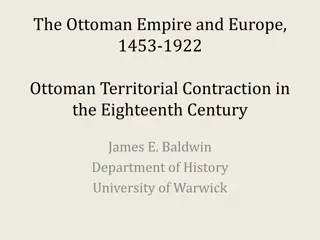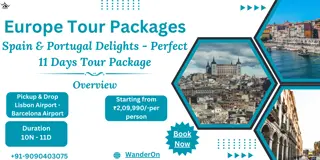Decline of Spain and Wars in the 17th Century
Spain's decline after 1635 was marked by financial strain and military challenges, leading to conflicts in Italy, the Pyrenees, and Catalonia. The war in the Empire post-1635 saw a shift in alliances and power struggles. The fiscal-military burden on Spain worsened due to declining trade and population, impacting its ability to sustain prolonged warfare.
Download Presentation

Please find below an Image/Link to download the presentation.
The content on the website is provided AS IS for your information and personal use only. It may not be sold, licensed, or shared on other websites without obtaining consent from the author.If you encounter any issues during the download, it is possible that the publisher has removed the file from their server.
You are allowed to download the files provided on this website for personal or commercial use, subject to the condition that they are used lawfully. All files are the property of their respective owners.
The content on the website is provided AS IS for your information and personal use only. It may not be sold, licensed, or shared on other websites without obtaining consent from the author.
E N D
Presentation Transcript
What is a primary source? not editorial introductions, comments, footnotes Leading class discussion: 10 March Colin, Pasha, Curtis article by David Parrot in The Military Revolution Debate (on reserve) article by Derek Croxton, Journal of Military History Leading class discussion: 12 March Thomas, Mark article by Mortimer in Early Modern Military History (on reserve)
Pyrenees: http://www.worldatlas.com/aatlas/infopage /pyrenees.htm Franco-Spanish War, 1635-1659: http://www.emersonkent.com/map_archive/ franco_spanish_war_1635.htm Spain s War with France and the Dutch Republic: http://www.emersonkent.com/map_archive/ thirty_years_war_1635.htm
1. Why did Spain decline after 1635? 2. How can we characterize the war in the Empire after 1635?
War in Italy, 1635-1642 France s objective close Valtellina pass restore control to Protestants Henri de Rohan French victory 1635 reverse 1636 Spain s alliance with heretics (p. 647) to regain transit through Valtellina lack of Protestant support for French conflict with Milan
War in Italy civil war in Savoy (1639-1642) France vs. Spain (1639-1640) stalemate death of Urban VIII (1644) Innocent X (1644-1655)
Attack on Spain Pyrenees two points of invasion West: Fuenterrabia East: Perpignan East: Salces 1638: West 1639: East Salces falls
Revolt in Catalonia, 1640 French figinting in Rousillon and Lerida Revolt of Portugal, 1640 Defenestration of Lisbon (1 December 1640) in response to demand for 6,000 troops War of Restoration (1640-1668)
Fiscal-military burden The monarchy remained rich, but it could no longer cope with the mounting cost of war (p. 655). silver imports Spain s transatlantic trade collapsed in 1638-41 (p. 659) rising taxes diminishing population The Army of Flanders was insufficient to fight both France and the Dutch Republic (p. 656). casualty and wastage rate: +20,000 per year after 1635 resistance to military service losses to Dutch in West Indies
Military defeats fall of Breda, 1637 Victory was no longer expected; the aim now was to leave the war with honour (p. 661). co-ordinated attacks by France and Dutch Republic, 1638 irrecoverable attrition rates affect on Empire: reduction in financial subsidies from Spain A Spanish success in the Netherlands would enable Ferdinand III to withdraw his troops from Luxembourg, while a Spanish defeat would free France to reinforce its army in Germany (p. 659).
Military defeats Olivares dismissed (1643) death of Richelieu (1642) and Louis XIII (1643) Cardinal Mazarin no quick peace with Spain territorial gains in the Empire Battle of Rocroi (1643) political significance for France
universal, anarchic and self-perpetuating violence (quoted on p. 622 from Michael Howard, War in European History [1976]) ??? a purposeful myth social, economic, administrative crisis Swedish plunder of Olm tz, 1642 (pp. 635-36) aftermath of the Battle of Tuttlingen, 1643 (p. 643) capture of French officers & wives attacks of peasants on stragglers casualties Second Battle of Breitenfeld, 1642 (p. 638) Battle of Jankau, 1645 (p. 695)
a mobile war increased proportion of cavalry rapid response to conflicts in poorly defended regions (p. 623) fewer sieges in the Empire (vs. Netherlands)
a war firmly controlled and directed (p. 624) no marked decline in the skill of either senior or junior officers (p. 624) France: Henri deTurenne Sweden: Lennart Torstensson Empire: Franz von Mercy
a war firmly controlled and directed (p. 624) neutrality Peace of Goslar (1642) Wolfenb ttel exchanged for Hildesheim Guelphs ceased hostilities. France and Sweden lose Lower Saxony as a base for operation Brandenburg cease-fire (1641), truce (1643) Saxony K tzenschenbroda Armistice (1645)
a war firmly controlled and directed (p. 624) financial way out Heidelberg: Bavaria France bishoprics of W rzburg, Bamberg Sweden neutrality in all but name (p. 640) Significance moves towards neutrality dispel the misconception of the war s later stages as generalized, unlimited destruction (p. 640) reduced the resources avaialable to the imperial war effort and discouraged the emperor s remaining supporters (p. 640). electors co-operated with princes and cities instead of relying on relationship with the Emperor
Regensburg Reichstag, fall 1641 united front against France and Sweden for German liberty expansion of amnesty: Hessen-Kassel, Palatinate an eighth electoral title
25 December 1641: Ferdinand III s gesture peace negotiations: France and Catholic states in M nster Sweden and Protestant states in Osnabr ck local neutrality, safe passage for envoys background: Guelph neutrality, Brandenburg- cease fire
Westphalian Congress, 1643-1648 a milestone in global relations (p. 671) the ideals and methods of the peace-makers have profoundly influenced the theory and practice of international relations to the present (p. 671) a ground-breaking event (p. 672) the first truly secular international gathering (p. 672) challenge to hierarchy move towards the modern concept of an order based on sovereign states interacting as equals, regardless of their internal form of government, resources, or military potential (p. 672)
Westphalian Congress, 1643-1648 participation 198 official participants (235 envoys and representatives) 178 participants from the Empire accompanying staff: bodyguards, servants, cooks, tailors, etc. total cost: ca. 3.2 M thalers Negotiations M nster, Osnabr ck Osnabr ck: most Imperial matters settled here Catholics and Protestants in both cities bilateral talks
representatives and objectives Spain: Count Pe aranda France: Claude de Mesmes, comte d Avaux Abel Servien comprehensive peace of Christendom mutually exclusive positions Spain: surrender of some towns in Artois
representatives and objectives Sweden: Johan Oxenstierna (p. 675) Empire: Maximilian, Count of Trauttmannsdorff Pomerania
conflicting interests of Sweden and France facade of German liberties Sweden: restoration of Palatinate Pomerania: how much? money France: favour of Bavaria interests of Imperial church division between Empire and Spain
Westphalian Congress, 1643-1648 phases 1. 1643-1645: Who may participate? 2. 1646-1647: imperial constitution; compensation / territories for France and Sweden 3. 1648: comprehensive treaty, exclusion from peace?
France and Sweden renewal of alliance (1641) division of military labour (p. 642) France: west of the Black Forest Sweden: Habsburg lands Battle of Wolfenb ttel (1641) Imperial victory casualties: 3,000 (Empire); 2,000 (allies) Battle of Kempen (1642) in Electorate of Cologne Hessen-Kassel in search of a victory for negotiations Allied victory reversal Swedish invasion of Silesia and Moravia, 1642 fortress of Olm tz
Sweden at war Second Battle of Breitenfeld (1642) Swedish victory War with Denmark (1643-1645) objectives invasion of Holstein (December 1643) fall of Christianpreis fort, Kiel (January 1644) naval war Imperial intervention, 1644 Kiel changes hands fall of Bremen and Verden Peace of Br msebro, 1645
Sweden at war Battle of Jankau, 6 March 1645 a disaster for the Emperor (p. 695) advance on Vienna, April 1645 brief co-operation with Transylvania diffused by Imperial diplomacy Imperial resilience and ingenuity (p. 698) negative strategic consequences
France at war Battle of Tuttlingen (1643) Imperial victory vs. France Battle of Freiburg (1644) Bavarians took Freiburg, 29 July the longest and one of the toughest battles of the war (p. 683): 3 and 5 August stalemate with heavy casualties French gains on middle Rhine Baden, bishoprics of Speyer and Worms, Philippsburg
France at war Battle of Herbsthausen / Mergenthehim, 5 May 1645 Imperial victory Battle of Allerheim, 3 August 1645 French strategic success (p. 704)
Participation of the Imperial estates in the Westphalian congress observers? Amalie Elisabeth, Hessen- Kassel, champion of aristocratic interests proposal: estates to meet in confessional groups support from Sweden and France Emperor: invitation to estates to participate in traditional three colleges (29 August 1644)
Imperial proposals concessions to Sweden Pomerania, Bremen, Verden 2. concessions to Brandenburg Magdeburg, Halberstadt concessions to France Alsace concession to Protestant estates abandonment of restitution concession to peace process abandonment of Spain in a separate peace if absolutely necessary 1. 3. 4. 5.























